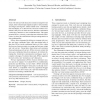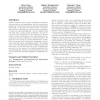96 search results - page 7 / 20 » Protecting browser state from web privacy attacks |
EUROSYS
2009
ACM
14 years 5 months ago
2009
ACM
Some web sites provide interactive extensions using browser scripts, often without inspecting the scripts to verify that they are benign and bug-free. Others handle users’ conď¬...
ACSAC
2003
IEEE
13 years 11 months ago
2003
IEEE
Web servers are ubiquitous, remotely accessible, and often misconfigured. In addition, custom web-based applications may introduce vulnerabilities that are overlooked even by the ...
CCS
2011
ACM
12 years 7 months ago
2011
ACM
Browser designers create security mechanisms to help web developers protect web applications, but web developers are usually slow to use these features in web-based applications (...
ACSAC
2010
IEEE
13 years 5 months ago
2010
IEEE
The JavaScript language is a core component of active and dynamic web content in the Internet today. Besides its great success in enhancing web applications, however, JavaScript p...
SP
2009
IEEE
14 years 2 months ago
2009
IEEE
– HTTPS is designed to provide secure web communications over insecure networks. The protocol itself has been rigorously designed and evaluated by assuming the network as an adve...


